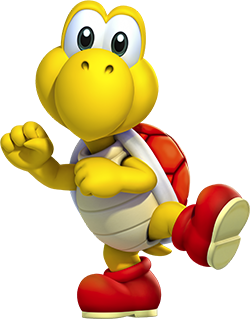
Koopa Troopas are a fictional turtle-like race of characters from the Mario media franchise. They are commonly referred to as Koopas, a more broad classification of creatures that includes Bowser, his Koopalings, and Lakitu. Predecessors to Koopa Troopas, Shellcreepers, first appeared in the 1983 game Mario Bros., while Koopa Troopas themselves debuted two years later in Super Mario Bros. (1985). Koopa Troopas are a common staple in most Super Mario and spin-off games. When defeated, they may flee from or retreat inside their shells, which can usually be used as weapons. Koopa shells are a recurring weapon in the franchise, particularly popularized in the Mario Kart series, in which they can be fired as projectiles against other racers. Despite making up the bulk of Bowser's army, Koopa Troopas are often shown to be peaceful, sometimes even teaming up with protagonist Mario.

Yoshi is a fictional dinosaur who appears in video games published by Nintendo. Yoshi debuted in Super Mario World (1990) on the SNES as Mario and Luigi's sidekick. Throughout the mainline Super Mario series, Yoshi typically serves as Mario's trusted steed. With a gluttonous appetite, Yoshi can gobble enemies with his long tongue, and lay eggs that doubly function as projectiles. Yoshi is the title character of the Yoshi series and a supporting character in Mario spin-off games such as Mario Party and Mario Kart, as well as many Mario sports games. He also appears as a playable character in the crossover fighting game series Super Smash Bros. Yoshi is a member of the same-named species, which is distinguished for its wide range of colors.

Princess Peach is a character in Nintendo's Mario franchise. She was created by Shigeru Miyamoto and introduced in the 1985 original Super Mario Bros. game as Princess Toadstool. She is the princess regnant and head of state of the Mushroom Kingdom, where she resides in her castle along with Toads. Since her debut, she has appeared in the majority of Mario video games as the main female character and the romantic interest of Mario. She has been voiced by Samantha Kelly since 2007.

Bowser, also known as King Bowser or King Koopa, is a fictional character and the main antagonist of Nintendo's Mario franchise. In Japan, his title is Daimaō. He is the arch-nemesis of the plumber Mario, and the leader of the turtle-like Koopa race. Bowser's defining traits are his monstrous appearance with dragon-like elements, full-throated roar, fire-breathing abilities, and tyrannical personality. His ultimate goals are to kidnap Princess Peach, make her his queen, and conquer the Mushroom Kingdom, and eventually the world.

Paper Mario is a 2000 role-playing game developed by Intelligent Systems and published by Nintendo for the Nintendo 64 home video game console. Paper Mario is the first game in the Paper Mario series. First released in Japan in 2000 and then internationally in 2001, Paper Mario was later re-released for Nintendo's Wii Virtual Console in July 2007, the Wii U Virtual Console in April 2015, and the Nintendo Switch Online + Expansion Pack on December 10, 2021.
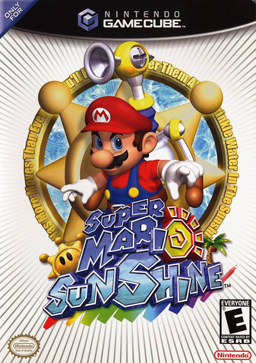
Super Mario Sunshine is a 2002 platform game developed and published by Nintendo for the GameCube. It is the second 3D game in the Super Mario series, following Super Mario 64 (1996). The game was directed by Yoshiaki Koizumi and Kenta Usui, produced by series creators Shigeru Miyamoto and Takashi Tezuka, written by Makoto Wada, and scored by Koji Kondo and Shinobu Tanaka.
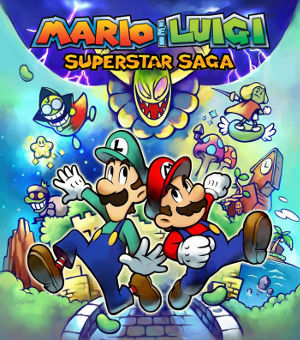
Mario & Luigi: Superstar Saga is a 2003 role-playing game developed by AlphaDream and published by Nintendo for the Game Boy Advance. It was re-released for the Wii U's Virtual Console in 2014, Nintendo Switch Online Service in 2023, and remade for the Nintendo 3DS as Mario & Luigi: Superstar Saga + Bowser's Minions in 2017. In the game, Mario and Luigi travel to the Beanbean Kingdom in order to combat Cackletta and Fawful, who stole Princess Peach's voice for the purpose of harnessing the power of a special artifact called the Beanstar.
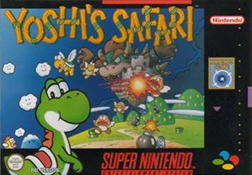
Yoshi's Safari is a 1993 light gun shooter developed and published by Nintendo for its Super Nintendo Entertainment System (SNES). It is the only Mario franchise game to feature first-person shooter gameplay and requires the SNES's Super Scope light gun. As Mario and his pet dinosaur Yoshi, the player embarks on a quest to save the kingdom of Jewelry Land from Bowser and his Koopalings, who have kidnapped its rulers and stolen 12 gems. The game features 12 levels in which the player shoots enemies like Goombas and Koopas, and collects power-ups and coins. At the end of each level, the player engages in a boss fight with an enemy, a Koopaling, or Bowser. Nintendo commissioned its R&D1 department to develop Yoshi's Safari in response to the waning popularity of the Super Scope. Yoshi's Safari was the first Super Scope title to use the SNES's Mode 7 graphics mode, and the future of the peripheral depended on the game's performance.

Mario Party is a party video game series featuring characters from the Mario franchise in which up to four local players or computer-controlled characters compete in a board game interspersed with minigames. The games are currently developed by NDcube and published by Nintendo, being previously developed by Hudson Soft. The series is known for its party game elements, including the often unpredictable multiplayer modes that allow play with up to four, and sometimes eight, human players or CPUs.

Paper Mario: The Thousand-Year Door is a 2004 role-playing game developed by Intelligent Systems and published by Nintendo for the GameCube. The Thousand-Year Door is the second game in the Paper Mario series following Paper Mario, and is part of the larger Mario franchise. In the game, when Mario and Princess Peach get involved in the search for a mystic treasure that holds great fortune, Peach is kidnapped by an alien group called the X-Nauts; Mario sets out to find the treasure and save the princess. A remake of the game for the Nintendo Switch was released on May 23, 2024.
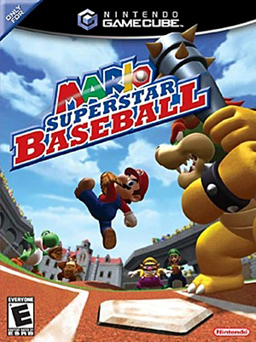
Mario Superstar Baseball is a 2005 sports video game developed by Namco and published by Nintendo for the GameCube. The game was created in the vein of other Mario sports games such as Mario Golf: Toadstool Tour and Mario Power Tennis. A sequel, Mario Super Sluggers, was released for the Wii in 2008.
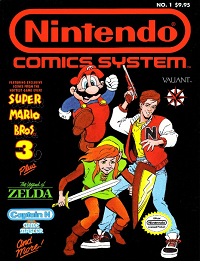
The Nintendo Comics System was a series of comic books published by Valiant Comics in 1990 and 1991. It was part of a licensing deal with Nintendo, featuring characters from their video games and the cartoons based on them.

Super Princess Peach is a 2005 platform game developed by Tose and published by Nintendo for the Nintendo DS. It was released in Japan in October 2005 and worldwide the following year. Super Princess Peach is the first game to feature Princess Peach as the main protagonist on a dedicated video game console and the second overall after Princess Toadstool's Castle Run released in 1990 on the Nelsonic Game Watch.

Super Mario Adventures is an anthology of comics that ran in Nintendo Power throughout 1992, featuring the characters from Nintendo's Mario series and based loosely on Super Mario World. In 1993, the series was also serialized in CoroCoro Comic in Japanese, under the title Mario's Big Adventure. Charlie Nozawa, the artist who created the comics, is also known by the pen name Tamakichi Sakura. Kentaro Takekuma was responsible for the story, which follows Mario and Luigi as they attempt to rescue Princess Toadstool after she is kidnapped by Bowser with intent to marry her.

Super Mario is a platform game series created by Nintendo starring their mascot, Mario. It is the central series of the greater Mario franchise. At least one Super Mario game has been released for every major Nintendo video game console. However, there have also been a number of Super Mario video games released on non-Nintendo gaming platforms. There are more than 20 games in the series.
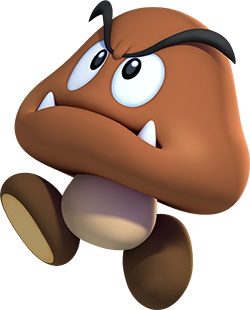
The Goombas, known in Japan as Kuribō, and originally Little Goomba, are a fictional species from Nintendo's Mario franchise. They first appeared in the NES video game Super Mario Bros. as the first enemy players encounter, part of Bowser's Army. They have appeared outside video games, including in film and television. They are usually brownish with long black eyebrows, sharp upward fangs, tan torsos, dark brown feet, and are most commonly seen walking around aimlessly, often as an obstacle, in video games. They were included late in the development of Super Mario Bros. as a simple, easy-to-defeat enemy.

Mario is a Japanese multimedia franchise created by Japanese game designer Shigeru Miyamoto for video game company Nintendo, which produces and publishes its installments. Starring the titular Italian plumber Mario, it is primarily a video game franchise but has extended to other forms of media, including television series, comic books, a 1993 feature film, a 2023 animated film, and theme park attractions. The series' first installment was 1983's Mario Bros. even though Mario made his first appearance in 1981's arcade game Donkey Kong and had already been featured in several games of the Donkey Kong and Game & Watch series. The Mario games have been developed by a wide variety of developers, including Nintendo, Hudson Soft, and AlphaDream. Mario games have been released almost exclusively for Nintendo's various video game consoles and handhelds, from the third generation onward.

Toad, known in Japan as Kinopio, is a character from the Mario franchise. The character was created by Japanese video game designer Shigeru Miyamoto, and is portrayed as a citizen of the Mushroom Kingdom and one of Princess Peach's attendants. Toad is typically a non-player character who assists Mario and his friends, but he occasionally appears as a protagonist.
















